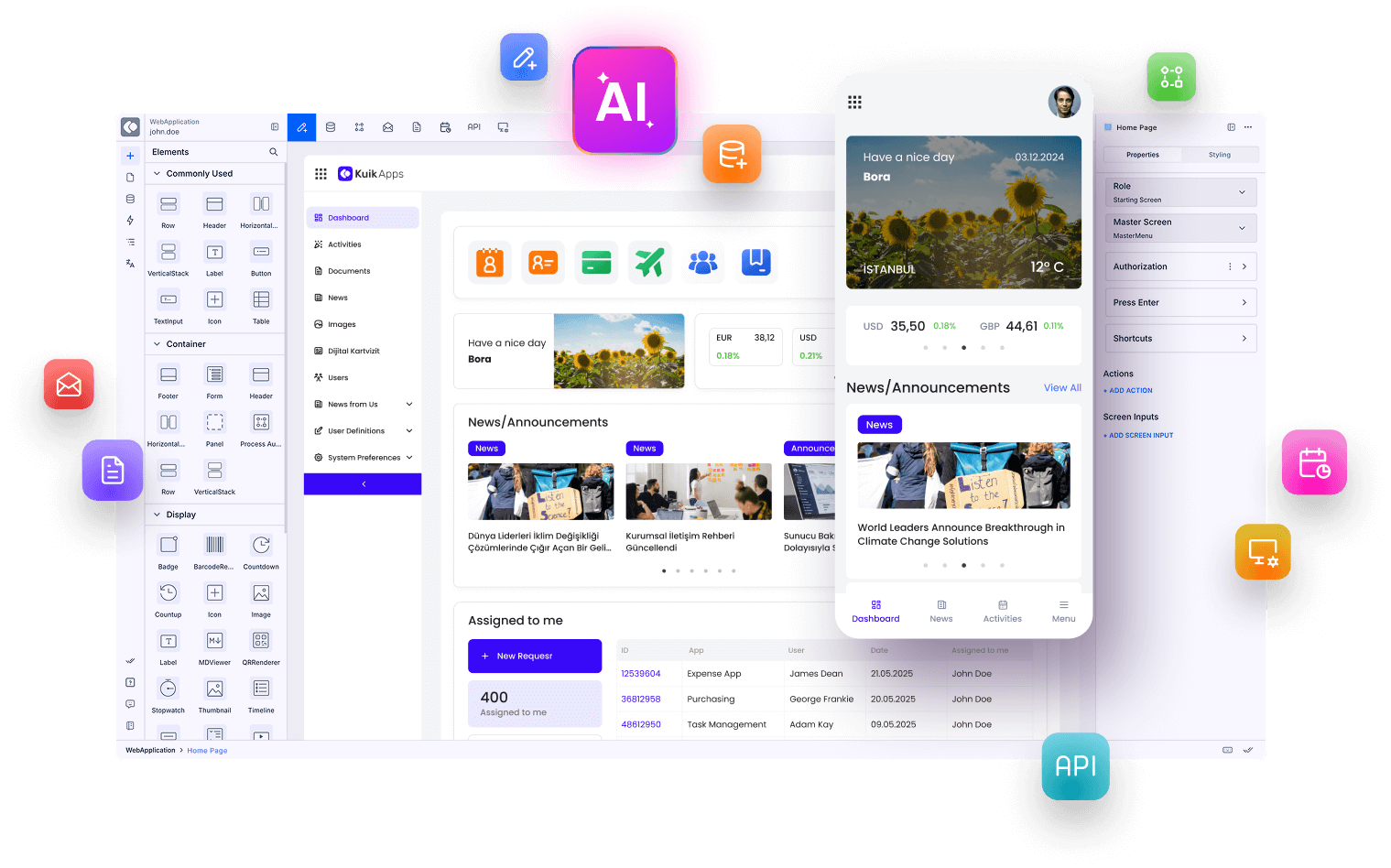Businesses and individuals from many different fields need software solutions. They need a software product when taking steps towards digitization, developing a new system, expanding the existing system, or looking for answers to their industrial needs.
Considering the constantly developing technology and the rapidly digitalizing world, software platforms that produce speedy solutions at low cost are now much more important. And here is low code, which offers solutions to meet this need!
Let's take a closer look at what low-code is as a gift of developing technology and why it is so important:
What is low code ?
Low code is a fresh method of creating software. It has become popular since traditional programming is highly sluggish and rigid.
Low code is a term used to describe software development platforms that allow for faster and easier development with less code. In other words, low-code platforms provide a visual drag-and-drop interface for creating applications rather than requiring traditional coding. This approach can greatly reduce both the time and effort spent on developing an application, making it more popular than ever before among businesses around the world.
Low-code platforms typically offer a wide range of built-in features and integrations, making it easy to get started with developing an application. However, low-code platforms can also be customized and extended to meet specific needs. Ultimately, low code provides a quick and easy way to develop high-quality applications without extensive coding knowledge.

How can you use low code to develop apps quickly and efficiently ?
Imagine being able to build an application without having any code! With low-code platforms, you can drag and drop your way through forms, create AI systems, or connect them to data sources in minutes. These tools come complete with built-in workflow management so that all the different components work together seamlessly for maximum efficiency.
It takes less time to create apps using visual approaches and models than writing code. This is because low-code platforms employ built-in components to represent any information in a form that can be read by anybody without technical knowledge and powered by visual modeling capabilities.
Low code is the answer for businesses looking to develop custom applications quickly and efficiently without a costly coding project. Low code also offers benefits such as being more accessible to users with limited experience in coding or those who may not even know how computers work at all. As demand continues growing, low code could become one essential tool every business needs.

Difference between low code and no code
Before moving forward, let’s make things more straightforward. What’s the difference between low code and no code?
Users must perform some level of coding in low-code development, albeit considerably less so than in traditional application development. Professional programmers and developers utilize low code to produce and upgrade applications swiftly. Low-code tools are also used by non-IT professionals who have some programming experience to create basic apps or enhanced features within an app.
No-code development caters to non-technical users in various business tasks who are aware of business requirements and regulations but have little to no coding knowledge. As long as the chosen tools are compatible with these common functions and capabilities, these citizen developers can build, test, and deploy their business apps quickly and easily using no-code platforms.
How does a low-code platform help ?
Development teams are always looking for new ways to increase efficiency while delivering high-quality products. One relatively new solution that is gaining popularity is low-code platforms. Low code platform, in contrast to traditional programming, provides quick application creation using visual models and drag-and-drop organization. This method allows for developing quicker and more dependable apps while using little to no coding.
Low-code platforms often come with a library of pre-built components that can be used to speed up the development process even further. As a result, they offer several advantages for development teams looking to streamline their workflow.
You can create apps, authorize them based on users, and combine them with other systems and services with low-code platforms.
Why is low code important ?
Here are some features that make low-code platforms important:
OOTB Capability
Leading low-code systems offer OOTB (out-of-the-box) capability that reduces the requirement to create application core modules from the ground up. For instance, some low-code platforms provide modules for customer-facing applications like service management, sales process management, or data management.
Easy-to-use features
There are drag-and-drop features incorporated into every low-code platform. It is among the most beneficial and significant elements that enable a simple development approach. Both amateur and expert developers utilize the drag-and-drop features offered during the construction of programs.

Pre-built usage
The usage of pre-configured modules and functionality for applications is a crucial component of low-code development. In addition, you may utilize these modules to create new solutions more quickly since they offer core functionality common to many applications.
A low-code platform must enable users to reuse pre-built or recently produced modules, plugins, and full applications to speed up the development of necessary applications.
Secure solutions
A low-code tool is only a sufficient answer if it is secure, regardless of how useful and easy to use it is. Ensure your low-code development platform has the right level of security before you use it to safeguard the apps you create and the platform as a whole. You can utilize a secure environment at Kuika.
Debugging, testing and deployment are just a few steps in the software development lifecycle that low-code technologies speed and simplify. For improved application lifecycle management, it gives users access to details about
- Newly developed applications,
- Their improvements and
- The option to roll back to earlier versions if necessary.
Benefits of low code
There are many points you can overcome by taking advantage of low code. Here are just a few of the benefits low code can bring to your business:
Allows you to have more possibilities
Without the requirement for intricate system coding, low-code platforms enable the needed modifications to be done rapidly. The ease of creating the program and addressing demands that occur while using it makes the application more agile due to its adaptable structure.

Creates fast and efficient solutions
Projects created fully using codes in traditional programming often take one year to complete. Still, projects created using low-code platforms might be finished in weeks or months, depending on their complexity. Low-code platforms make it possible to build apps faster.
Reduces the cost of your work
The capacity to produce more apps in less time lowers costs. As there is no longer a need for a software developer, it also reduces the cost of hiring new employees. Everyone can become more productive thanks to low-code platforms—not only programmers.
Values development
There must be a transition in the current digital environment. Platforms with little to no code reduce complexity, hasten transition, and thereby accelerate development.
Adapts to changes
Businesses that use the low code platform successfully may swiftly adjust to market changes and client demands. With the flexibility that low code brings, it becomes easier to adapt.
The most popular low-code use cases
Low code is used in many ways around the world. We are going to see some popular examples of it.
- Developing custom web and mobile apps
- Automating business processes
- Creating prototypes and MVPs
- Building BPMs
- Integrating disparate systems
- Creating dashboards and reports
- Deploying applications quickly
- Designing UI
- Switching to microservices
To learn more about low-code use cases, read on our related article.
Tips for choosing the right low code platform for your needs
When it comes to choosing a low-code platform, there are a few important factors to keep in mind. First, consider the type of application you want to build. If you're looking for something simple, like a basic CRUD app, then you might not need all the bells and whistles that come with more sophisticated platforms.
Also, think about your development team's skills and experience. If you're working with experienced developers, they'll likely be more comfortable with a platform that offers more flexibility and customization. However, if you have a less experienced team, then a platform with drag-and-drop components and built-in templates is a must. Also, remember that the latter will make things faster, even for experienced teams.
Finally, make sure to consider your budget. The price of low-code platforms can be quite high, so choosing one that fits your price range is important. By considering these factors, you'll be well on your way to choosing the right low-code platform for your needs.

To sum up
Low-code platforms have revolutionized the way we develop applications. They provide an efficient and user-friendly way to create custom applications without requiring extensive coding knowledge. Additionally, low-code platforms can be used to develop prototypes and MVPs quickly and easily, which can be extremely helpful for startups and businesses looking to test new ideas.
This system
- allows you to adapt to changes and create fast solutions,
- lightens most of your burden on software and
- Frees your energy and time to enable you to transfer your creativity to other environments thanks to its user-friendly interface.
If you're interested in using a low-code platform to develop your next application, Kuika offers a free trial to try it out before buying. We hope you've found this information helpful !
















